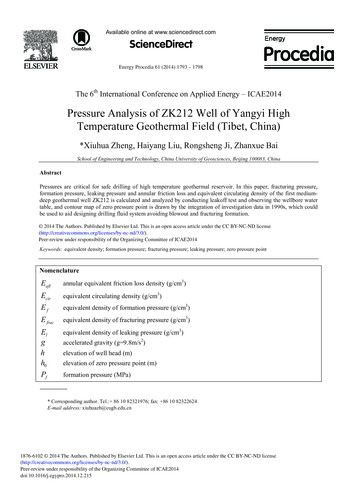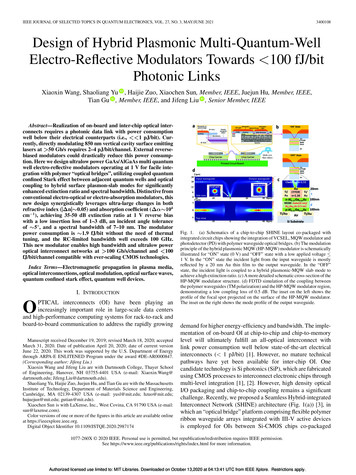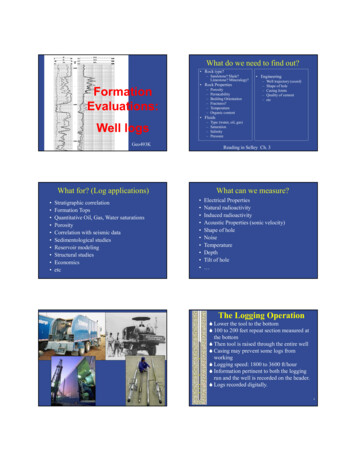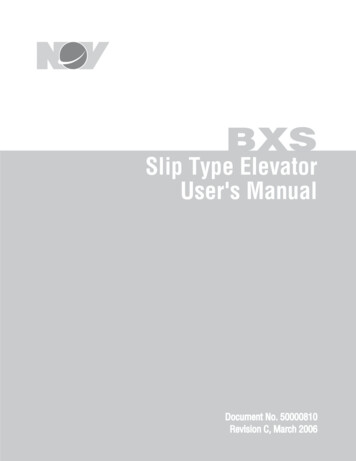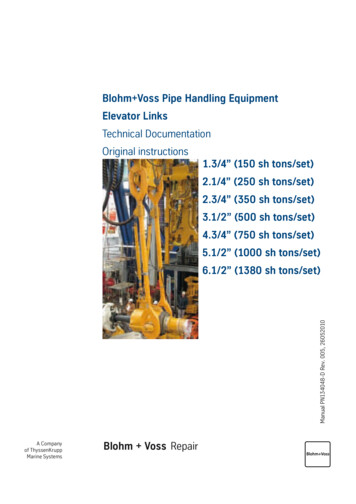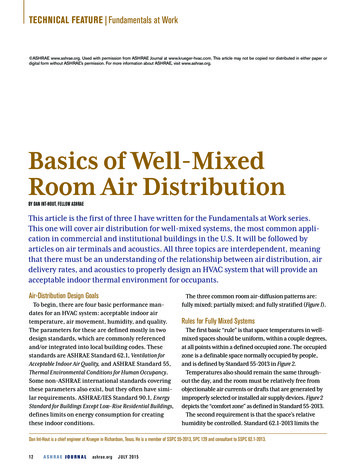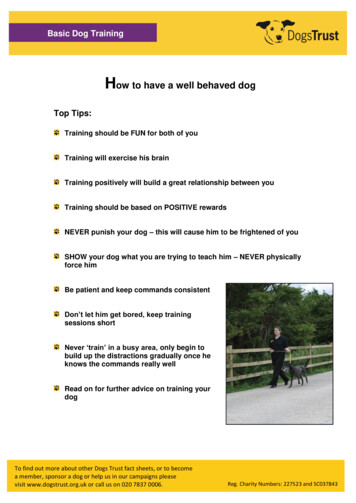
Transcription
Basic Dog TrainingHow to have a well behaved dogTop Tips:Training should be FUN for both of youTraining will exercise his brainTraining positively will build a great relationship between youTraining should be based on POSITIVE rewardsNEVER punish your dog – this will cause him to be frightened of youSHOW your dog what you are trying to teach him – NEVER physicallyforce himBe patient and keep commands consistentDon’t let him get bored, keep trainingsessions shortNever ‘train’ in a busy area, only begin tobuild up the distractions gradually once heknows the commands really wellRead on for further advice on training yourdogTo find out more about other Dogs Trust fact sheets, or to becomea member, sponsor a dog or help us in our campaigns pleasevisit www.dogstrust.org.uk or call us on 020 7837 0006.Reg. Charity Numbers: 227523 and SC037843
Basic Dog TrainingThe kind, fair and effective wayTraining can be started at any age, the sooner the better. You can start simple training withyour puppy as soon as he has settled into his new home. Older dogs are also receptive totraining, although some may be less keen or less quick to learn than a younger dog. Doneproperly, training will be fun, both for you and your dog, as well as exercising his brain andreinforcing the good relationship between you.Positive rewardsIn order to be effective and to gain the best results, all training should be based aroundpositive rewards. Positive reward training works because if you reward your dog withsomething he wants as soon as he does what you ask, he is far more likely to do it again.Rewards can be anything that your dog or puppy really wants and could include; food treats, afavourite toy, playing a certain game or getting a pat. However, really tasty treats will usuallywork best – try small pieces of dried liver, hotdog sausage, chicken or cheese for maximumeffect. If you are using food treats, you will need to reduce the size of your dog's normal mealsor use his whole meal divided up into smaller portions, to prevent your dog putting on weight.Always combine the giving of a reward with verbal praise such as "Good dog".When teaching a new command, you will need to reward your dog every time that he doeswhat you ask correctly. Once he has the hang of the command, however, it’s a good idea tochange the way you reward by only giving the reward every now and then, because this willmake your dog try harder for it. Always verbally praise your dog each time, even if he is notbeing rewarded with a treat.Why punishment doesn't workPunishment should never be used in training. If you punish your dog, it will only teach him tobe scared of you and may eventually teach him to be aggressive. He will mistrust you andyour relationship may break down completely.Avoid punishment in training (and everyday life) by trying the following – it’ll be far moreeffective and could improve your relationship with your dog:Reward all wanted behaviour – so that your dog is likely to repeat it in the future.Ignore unwanted behaviour – so that your dog is less likely to repeat it.Avoid triggering the unwanted behaviour – avoidance prevents the unwantedbehaviour from happening in the first place!Where unwanted behaviour cannot be ignored or avoided, train an alternative,acceptable behaviour for your dog to perform instead. It is much easier to train a dogto do something else that you don’t mind, than to train him to completely stopsomething that you do not like. For example, if your dog jumps up at people, teach hima really good ‘sit’ command and ask for this when meeting others. If he is rewardedwith treats and attention every time he sits, he’ll soon automatically be doing this whenhe meets people, instead of jumping up!To find out more about other Dogs Trust fact sheets, or to becomea member, sponsor a dog or help us in our campaigns pleasevisit www.dogstrust.org.uk or call us on 020 7837 0006.Reg. Charity Numbers: 227523 and SC037843
Basic Dog TrainingThe basic commandsFive basic commands that are useful for your dog to know are; sit, down, stay, come andwalking nicely on the lead.This is our guide to training in a kind and effective way:Sit1) Have your dog standing in front of you.2) Show him that you have a food treat in your hand.3) Slowly move your hand and treat above and over his head towards his tail, as you givethe command "sit".4) His head should go up as he tries to reach the treat, and his bottom should go downinto the 'sit' position.5) Give him the treat and praise him.Do not push his bottom down to make him sit, as he is likely to push up against your hand asa result and this may hurt his back.When training your dog to sit, use the command "sit". Do not use "sit down" as this mayconfuse your dog when you try to teach the 'down' command.Down1) Ask your dog to sit and show him the treat in your hand.2) Slowly move your hand down towards the ground in front of him (just in front of hisfeet), as you use the command "down". He should follow your hand with his nose andlay down.3) Give him the treat and praise him.If you have trouble getting him to lie down in this way, put an object such as a coffee table or achair between you and your dog and try again. He will have to lie down to get under the barrierto get the treat. Remove the barrier when he gets the hang of it.Do not push or force his back down as he will push against you and this may hurt his back.Stay1) Ask him to sit or lay down.2) Take one step away from him as you command him to "stay".Silently count to three.3) Step back to him, treat and praise.4) If he gets up, ask him to sit again and repeat the procedure.Once he is doing this short 'stay' command correctly, gradually increase the distance betweenyou and your dog and/or the time that he is asked to stay. If he gets up when he is notsupposed to, go back a stage to a shorter distance or time, and then increase again slowlyuntil he is doing as he is told every time.To find out more about other Dogs Trust fact sheets, or to becomea member, sponsor a dog or help us in our campaigns pleasevisit www.dogstrust.org.uk or call us on 020 7837 0006.Reg. Charity Numbers: 227523 and SC037843
Basic Dog TrainingWalking on a lead without pullingPractice in your home and garden first as there are fewer distractions for your dog than in thestreet.1) Choose which side you would like your dog to walk on and then stick to it.2) Hold the lead in the opposite hand – keep it loose (if it is too tight, your dog will pull intoit) – and put a treat in the hand nearest your dog.3) Show your dog the treat and walk forwards.4) As he follows your hand, say “heel” and give him a small bit of the treat.5) Keep some treat in your hand and keep going. As he keeps to your side, say “heel”and give him some more treat. Don’t stop walking.6) If he doesn’t keep up with you, or pulls in a different direction, suddenly changedirection and encourage him to come with you. Praise him when he catches up andgive him some treat. He’ll soon get the idea.It is a natural, enjoyable behaviour for a dog to want to find out what is happening in his localarea by sniffing the ground, lamp posts and fences for scents left by other dogs. On walks youshould allow him to have a sniff around. When you are ready to let him do this, use acommand such as "off you go", so that he can learn when he is allowed to do this. You coulduse this loose lead 'freedom' as a reward for when he has been performing well on the lead.How to train your dog to come to youAll dogs need a good run off-lead in a safe place at least once a day to help them stay happyand fit and to get rid of some of that excess energy that can lead to mischief-making.However, it’s an owner’s legal responsibility to ensure that their dog is under control at alltimes in a public place – so being able to get your dog to come back to you when you call himis very important.Stage One - introducing the basic idea that coming to you is a good thing!Feed your dog normally (preferably at least twice a day) – if you are worried that yourdog may be overweight, reduce the size of his main meals slightly during the trainingperiod.Find treats that he really likes eg small pieces of liver, chicken, hotdog sausage orcheese.Keep a pot of these in the fridge, so that you have access to treats at any time of theday.Pop some treats in your pocket and at random times when you are in the same roomtogether, call him to you in a happy voice and give him a treat. After he has finished histreat, say something like “good dog – off you go!”.Repeat this frequently during the day, for a few days, until he is coming to you quicklyevery time.Tips for better successNever train when he’s really hungry – this can make him frustrated and it’ll be difficultfor him to concentrate.If using the command “come” hasn’t worked up to now, this is a good time to change it.Try “here” or perhaps even a whistle which can be easier for a dog to hear when outon the park. Once you choose a new command you must stick to it, or you’ll confuseyour dog and he may never learn what you really want him to do.To find out more about other Dogs Trust fact sheets, or to becomea member, sponsor a dog or help us in our campaigns pleasevisit www.dogstrust.org.uk or call us on 020 7837 0006.Reg. Charity Numbers: 227523 and SC037843
Basic Dog TrainingEven though your dog may already be happy to come when you call him in the home,you still need to do this initial bit of training and turn it into a great game for your dog.Skipping a stage may affect the rest of the training.Initially, walk your dog on a long or extending lead, until you complete all of the stages.If you punish him in any way for not coming to you on a walk, during this early trainingtime, it may undo all the good work.Stage Two – coming when he can’t see youNow it gets even more fun for your dog. Do exactly the same as in stage one, but callhim from another room or part of the house.When he comes every time, call him from the garden as well.Your dog should be having great fun by now trying to find you when you call him. Dothis for a week and if he is coming every time when you call, you can move onto thenext stage.Stage Three – keep him guessing and he’ll try even harder!Change the type of treat from time to time and sometimes give him more as a big‘jackpot’. Other times play a game with his favourite toy when he reaches you or justgive him lots and lots of praise and cuddles.If you change the reward every time that you call him, this will actually make him tryharder to get it right - just in case he hits the ‘jackpot’ i.e. the treat, game or fuss thathe wants the most. Strangely enough it has the same effect as gambling has onhumans! You can use this with training any command – not just the recall.When your dog understands exactly what the recall command means he shouldrespond to it at speed, every time you use it. Now try it outside in public places.Stage Four - the great outdoorsFind a quiet area – other dogs running around may be a distraction.It’s important that your dog gets the command right every time at this point. You canslowly build up to higher levels of distractions, but only as long as your dog keepsgetting it right.Remember to feed your dog 45 minutes to an hour before training on walks.Keep your dog on the extending lead or long line, so that he cannot get away or out ofsight. Let him go to the end of the lead and enjoy sniffing around.When you are ready, call him to you and wait. Do not pull him to you - he must come toyou out of choice.When he does, give him his reward, praise, then “good dog – off you go!” and let himgo off sniffing again.Repeat this several times during his walk, so that he learns that coming to you will notautomatically mean it’s the end of his walk.Tips for better successDo this outdoors training for around two weeks and if possible, try to do it in differentlocations – i.e. the park, a friend’s garden, a different park from usual, the woods, acountry park etc. This will help your dog to learn to come to you wherever you are inthe future.Never tell your dog off if he doesn’t come to you on command. If your dog thinks thatyou are going to punish him he won’t want to come to you at all. Always praise him forcoming to you, no matter how long it has taken him.To find out more about other Dogs Trust fact sheets, or to becomea member, sponsor a dog or help us in our campaigns pleasevisit www.dogstrust.org.uk or call us on 020 7837 0006.Reg. Charity Numbers: 227523 and SC037843
Basic Dog TrainingStage Five - free running, but still in controlWhen your dog is coming to you every time when called on the long line, you can try lettinghim off the lead completely.Initially try this in a quiet area, so that he doesn’t completely forget his training at thefirst sight of another dog.Again, build up the level of distractions slowly, so that you can make sure he sticks tohis training. If you are not careful, he could quickly go back to old habits.Do let him have a little play with other dogs if he is friendly with them. Call him backafter a few minutes; he should come to you if you have trained him well.Once you are confident he knows his recall command, you can start to graduallyreduce the treats – but remember to praise him every time and continue to give himtreats occasionally.Try to have fun with your dog on your walks by taking his favourite toys and playinggames, getting him to come to you and then letting him go again to play. If you keephis interest with enjoyable games, he won’t want to run off in the first place.Walks are one of your dog’s daily highlights – involve yourself actively and your dogwill want to be with you.'Important Training Tips' - doggy 'do's and 'don'tsDoPractice in your home and garden first, before trying commands in public areas.Start training with your new dog or puppy as soon as possible.Keep sessions short (5-10 minutes max) and fun.Reward or treat him on a random basis, once the new comma
This is our guide to training in a kind and effective way: Sit 1) Have your dog standing in front of you. 2) Show him that you have a food treat in your hand. 3) Slowly move your hand and treat above and over his head towards his tail, as you give the command "sit".



